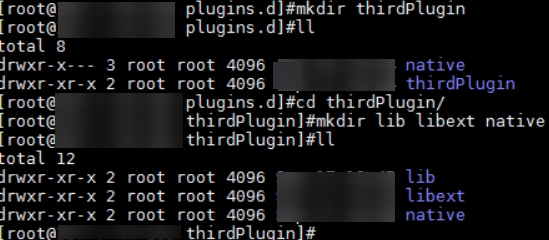Secondary Development Guide for Flume Third-Party Plug-ins¶
Scenario¶
This section describes how to perform secondary development for third-party plug-ins.
This section applies to MRS 3.x or later.
Prerequisites¶
You have obtained the third-party JAR package.
You have installed Flume server or client.
Procedure¶
Compress the self-developed code into a JAR package.
Create a directory for the plug-in.
Access the $FLUME_HOME/plugins.d path and run the following command to create a directory:
mkdir thirdPlugin
cd thirdPlugin
mkdir lib libext native
The command output is displayed as follows:

Place the third-party JAR package in the $FLUME_HOME/plugins.d/thirdPlugin/lib directory. If the JAR package depends on other JAR packages, place the depended JAR packages to the $FLUME_HOME/ plugins.d/ thirdPlugin/libext directory, and place the local library files in $FLUME_HOME/ plugins.d/ thirdPlugin/native.
Configure the properties.properties file in $FLUME_HOME/conf/.
For details about how to set parameters in the properties.properties file, see the parameter list in the properties.properties file in the corresponding typical scenario Non-Encrypted Transmission and Encrypted Transmission.
Note
$FLUME_HOME indicates the Flume installation path. Set this parameter based on the site requirements (server or client) when configuring third-party plug-ins.
thirdPlugin is the name of the third-party plugin.